Suspension bridges are far and away the target of choice in America’s action blockbusters. In just the past three years, the Golden Gate Bridge has been destroyed by a Kaiju, Godzilla, a Skynet-initiated nuclear blast, and a tsunami. Americans don’t build real bridges anymore, or maintain the ones that we have, but we sure love to blow them up in movies.
There is logic here: A disaster scene involving a famous bridge serves both to root the film in the real world and to demonstrate the enormity and the immediacy of the threat. The unmaking of these huge structures shocks us because many bridges have gained an aura of permanence in our collective consciousness. Although we know when the Brooklyn Bridge was built and who built it, we feel like it has always been there and always will be. The destruction of our familiar human topography is even more disturbing than the deaths of the CGI victims, and I’m not just saying that as a misanthrope who loves bridges.
However, in all of the planning, storyboarding, rendering, and compositing of these special effects shots, nobody pauses to consider how suspension bridges actually behave. I can accept messianic alien orphan superheroes and skyscraper-sized battle robots, but I will not stand for inaccurate portrayals of structural mechanics. It’s fine to bend the laws of physics if the plot warrants it, but most suspension bridge mistakes are so needless and stupid that their only function seems to be irritating engineers.
How Suspension Bridges Actually Work
The construction of a suspension bridge is a huge, challenging undertaking, but the basic physical principles are fairly simple: First, two towers (or sometimes more) are built. A pair of thick steel cables (made of thousands of smaller strands) are strung from shore to shore, resting on big saddles atop each tower. These main cables will form a parabola and support a series of vertical suspender cables, which in turn support the road deck. At each shore, huge anchorages keep the main cables in place.
When you drive across a suspension bridge, the weight of your car pulls down on the vertical suspender cables, putting them in tension. That tensile force is then transferred into the main cables, also in tension. The main cables pull downward on the towers, which resist the vertical compression force by carrying it into the foundations. Finally, at the ends of the main suspension cables, the massive anchorages resolve the tensile force.
On the big screen, these basic concepts don’t apply. Most of the structural elements have no purpose, and bridges are instead supported by a mix of perplexing whimsy, directorial ignorance, and nothing. I’ve taken a look at some notable suspension bridge disaster scenes and listed them from least bad to most bad:
Final Destination V
The most realistic bridge collapse sequence somehow comes from a film franchise in which people regularly get cut in half by errant kites. In this chapter, Sam Lawton is stuck in traffic on the North Bay Bridge in western New York (played by Vancouver’s Lions Gate Bridge, the only non-iconic bridge on this list) when he notices that cracks are splaying out from a point where some workers are cutting up the road. These cracks widen, and soon the vertical cables start to pop out of their connections to the main suspension cables and to the beams under the road deck. A progressive collapse ensues, as each vertical suspender fails to compensate for the loss of its neighbor.
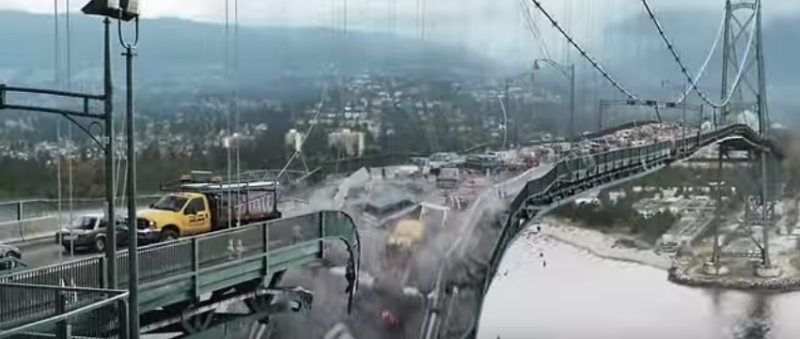 The origin of the structural failure in this situation is pretty absurd because the asphalt driving surface on a traffic bridge is non-structural. The road itself rests on a steel structure, which would probably not be seriously compromised by some sawing and jackhammering on the asphalt. Further, it’s hard to invent a scenario in which any of this could cause a failure at the top of a vertical suspender. But who knows, maybe there had been some plot-friendly corrosion in the steel. Regardless of the initial cause of failure, the collapse progresses in a halfway believable manner: The road deck falls, but the main catenary cables and the bridge towers remain. With no road to support, the vertical cables swing dumbly over the void.
The origin of the structural failure in this situation is pretty absurd because the asphalt driving surface on a traffic bridge is non-structural. The road itself rests on a steel structure, which would probably not be seriously compromised by some sawing and jackhammering on the asphalt. Further, it’s hard to invent a scenario in which any of this could cause a failure at the top of a vertical suspender. But who knows, maybe there had been some plot-friendly corrosion in the steel. Regardless of the initial cause of failure, the collapse progresses in a halfway believable manner: The road deck falls, but the main catenary cables and the bridge towers remain. With no road to support, the vertical cables swing dumbly over the void.
On a pedantic note (as all best notes are), the collapse shown in the film does not accurately reflect the change in shape that the real parabolic cables would take. Without the dead weight of the main span, the main cables would sag noticeably less between the towers because they would only be carrying their own weight. Since the cables themselves cannot appreciably change in length, they would droop much more at the outer spans where the load is still applied. In the movie, the intact portions of the road deck should be sagging much lower. This is a rare fictional collapse scenario for which we have a real world comparison, the 1940 Tacoma Narrows Bridge collapse.
I Am Legend
The government blows up the Brooklyn and Manhattan Bridges in order to head off an outbreak of the movie’s mysterious virus. The explosions sever the main cables, and the center spans of the bridges drop into the East River while the towers remain standing. This would be a fairly accurate representation of the physics of a suspension bridge, except the spans between the towers and the shore are shown to be unaffected.
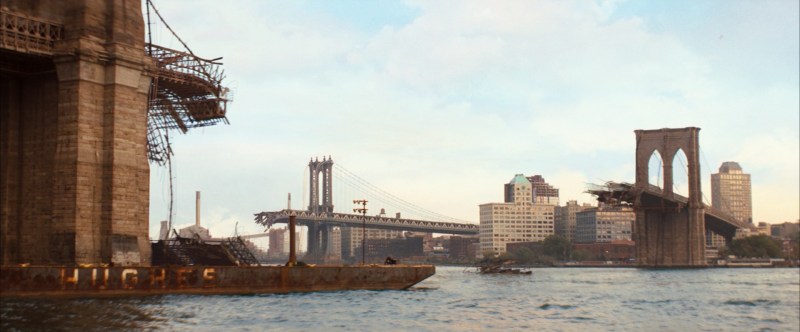
However, the loss of tension capacity in the main cables would cause a total collapse of the entire bridge deck, not just the central span. The road deck at the outer spans is still pulling downward on the main cables, which would normally go into tension and resist the load. But since those main cables are severed, there is nothing to pull against, and the necessary structural capacity cannot be developed. (Pacific Rim makes the same mistake, showing a flash of the destroyed Golden Gate Bridge with the center span destroyed and outer spans still present.)
X-Men: The Last Stand
Magneto, whose mutant power is dominance over all things metal, rips the Golden Gate Bridge off of its foundations, flies it over the San Francisco Bay, and places it between the city and Alcatraz Island. (This insane act of destruction serves only to transport his army of mutants from point A to point B, a basic logistical task that he could accomplish by lifting a couple of buses instead). Magneto pulls up the bridge towers and severs the suspension cables directly at their anchorages, effectively removing any means by which the structure can transfer load into the Earth. However, if we grant Magneto the ability to lift the bridge in the first place, then can also assume he has the ability to resolve all the structural forces within the bridge as well. So far, so good.
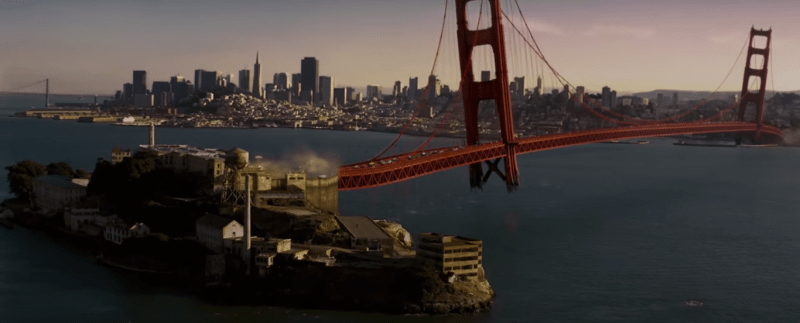
However, when Magneto drops the bridge between Alcatraz and (what looks like) the Marina District, the same structural problems are still present even though he isn’t actually supporting it anymore. The road deck forms an arc from shore to shore, the towers hover bizarrely over the water, and the main suspension cables still carry load. We could convince ourselves that Magneto is graciously holding up the bridge during the climactic battle, but that logic unravels when Magneto is “cured” of his mutation and therefore loses his ability to control metal. The whole bridge apparatus should crash into San Francisco Bay in a tangle of useless rubble. (Not that it really matters because apparently nothing matters, but the Golden Gate Bridge isn’t long enough to span the distance depicted even if the structural forces could be resolved.)
Godzilla (2014)
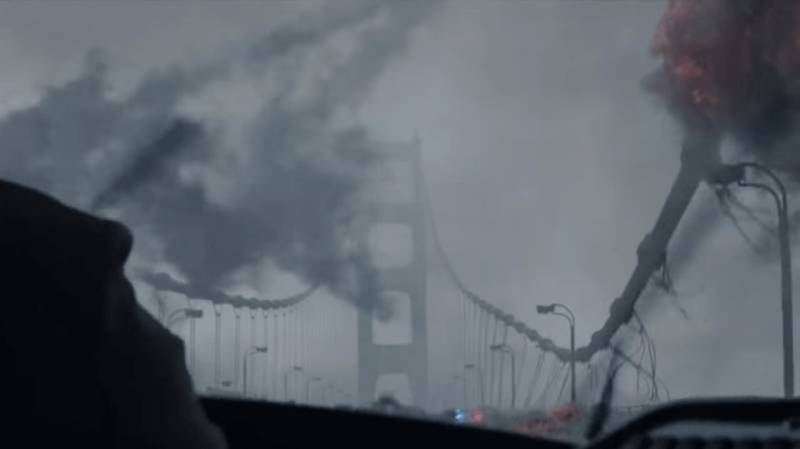 An errant army missile completely severs one of the Golden Gate Bridge’s two main cables. The loss of that cable, which had been supporting the right side of the road deck, should result in a catastrophic collapse: Without one of its two vertical supports, the road deck would hinge downward like a trap door, dropping all the tanks and school buses into the water below.
An errant army missile completely severs one of the Golden Gate Bridge’s two main cables. The loss of that cable, which had been supporting the right side of the road deck, should result in a catastrophic collapse: Without one of its two vertical supports, the road deck would hinge downward like a trap door, dropping all the tanks and school buses into the water below.
However, in the film world, bridge suspension cables are purely decorative elements that can be destroyed without consequence. The soldiers continue to battle Godzilla and the drivers motor across the bridge to safety, all oblivious to the physics errors that spared their lives. Godzilla even tugs at the remaining cable, which should at least cause the impossibly floating road deck to sway, but it doesn’t. Even when Godzilla busts through the center of the main span, the function of the bridge is unaffected.
The Dark Knight Rises
Bane blows up a series of bridges (actually some New York City bridges with some fictional CGI additions) to cut Gotham off from the world. Explosions sever the suspension cables and the road decks all at once, and a neat section of each bridge falls into the river below. Nothing else happens. That’s it. Completely cutting the main structural element on a suspension bridge has no effect on the structural integrity as a whole. Movie magic. (I must note that the bridge featured in the movie’s climax is a cantilever bridge and therefore outside the scope of this article.)
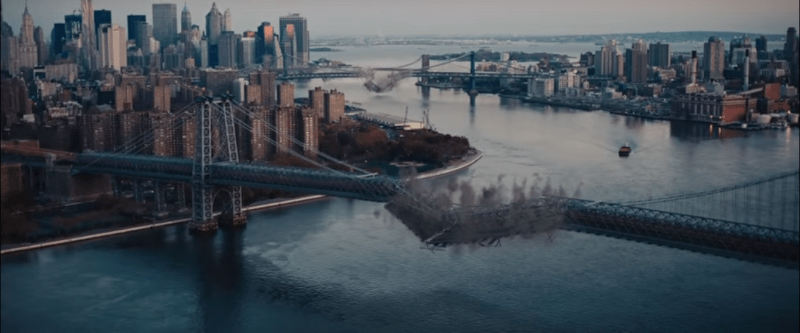
Imagine stringing a clothesline between two buildings and putting some shirts out to dry. Now, cut the line in the middle. In our world, the line loses all its capacity and the shirts all fall to the ground. In Christopher Nolan’s world, the clothesline is unharmed and, who knows, may actually be stronger.
I consider this the worst suspension bridge destruction scene in motion picture history. The Golden Gate Bridge collapse in The Core is somehow more realistic than this. Nolan, who famously hired astrophysicist Kip Thorne to advise him on black holes for Interstellar, failed to hire a sophomore engineering student to explain regular gravity here on Earth.
A Bridge Too Far
There are a few reasons why these mistakes keep happening during America’s annual summertime bridge demolition derby. I grudgingly concede that a director’s top priority is to tell a story rather than present a technically accurate demonstration of bridge mechanics. Also, suspension bridges don’t fall down very often in the real world, which means that the general public has no actual collapse imagery to use as a reference point. Finally, these movies are made and marketed for teenage boys and young men who want to see stuff explode. The bigwigs at Warner Brothers aren’t really aiming for that big structural engineer dollar.
However, since we’re in an era when many filmmakers are producing grittier, more realistic action movies, I still hold out hope that someone will get this right. If there are any Hollywood screenwriters, directors, or special effects artists inexplicably reading this post, please do me a favor: The next time you blow up a bridge, spare a thought for the people who actually build them.
Alex Weinberg, P.E. is a structural engineer living and working in New York City. You can e-mail him at a@alexweinberg.com.

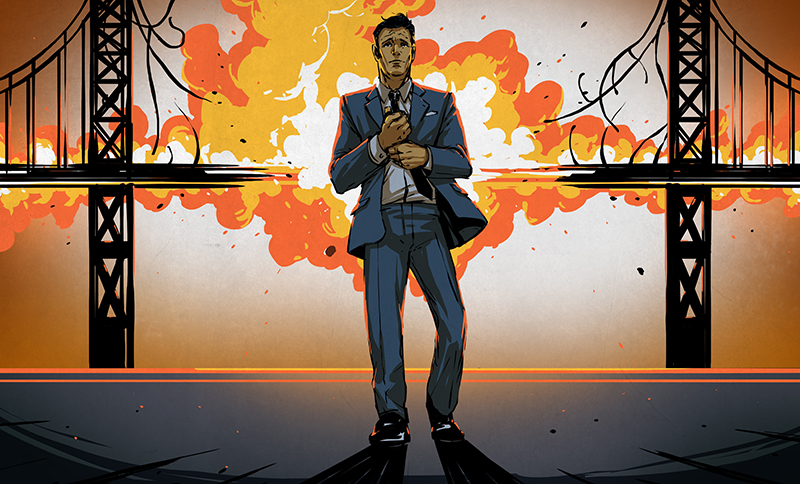
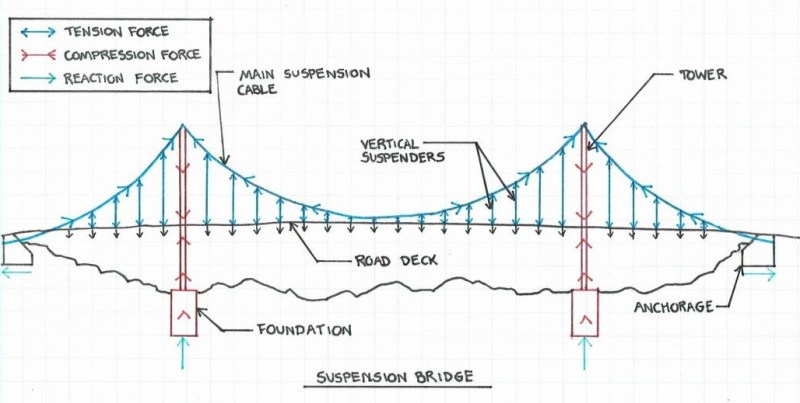














What? No gratuitous Tacoma Narrows Bridge? My son now lives in Tacoma, and driving across the (rebuilt) bridge I’ve seen over and over in black and white was a “must” on my first trip out to see him.
…and I noted that the rebuilt span contains a central venting grid…so the engineers who designed the new bridge took extra care to avoid having their creation star in a sequel.
It isn’t the vents. The original had a box structure – U shaped with the open part facing downward, with solid sides instead of open-work trusses for wind. This is how the oscillations were driven. It was a problem from opening day, when my folks drove across it. The replacement is all open beam and truss. The vents are not very big and do more to drain rain water and reduce weight. The new sister bridge is concrete and cable. Note to Alex: A catenary is not a parabola. But it is the solution to the Brachistachrone Problem.
Where did he say a catenary was a parabola…?
On a pedantic note (as all best notes are), the collapse shown in the film does not accurately reflect the change in shape that the real parabolic cables would take.
A catenary is the shape of a unweighted chain. A parobola is the shape of a chain that supports evenly spaced weights.
A catenary is the curve made by a free-hanging chain (Latin: catena = chain). A cable with a uniform load traces a parabola. Alex is right – the curve of a suspension bridge’s cables is a parabola.
Well, a catenary is certainly not a parabola, but neither is it a solution to the brachistochrone problem – that is the cycloid instead. (By the way, the catenary is the shape of an unloaded cable; I don’t know which curve it is once we add the bridge deck).
There’s a link to it in the article.
Thanks! Looking for picture, missed the link.
Was cool to drive across it in real life, as they re-used the original towers with a new deck & cables.
I was living up there when a second parallel bridge was being built to help ease traffic congestion. having come from florida that was an amazing bridge to ride over.
The Mighty Mac in Michigan also has the aerodynamic grating in the center. Alex, I beg your pardon, the Americans in Michigan maintain that bridge quite zealously. http://www.mackinacbridge.org/projects-19/
I think you’re definitely right on the Manhattan Bridge. It’s a classical suspension bridge. The Brooklyn Bridge is part suspension/part cable-stayed. I don’t have a good feel for how it would react if the main cables went. Probably depends on the exact construction.
The diagonal cables on the Brooklyn Bridge are generally considered to be unneeded elements that were left in place for aesthetic appeal.
…Really? The original designer of the Brooklyn Bridge had them there as a three-system redundant support structure. In fact, he flat out said that: “The East River Bridge will form a large truss of 1600 feet span, and a depth of 150 feet. The towers form one supporting element, the framing of the floor forms the second, and the extensive system of stays forms the third. The stays are arranged in four distinct planes, connected by the floor. The latter, in connection with the stays, will support itself without the assistance of the cables.”
(I don’t know about any renovations since then, obviously. It’s not like the US is famous for maintaining overengineered designs.)
This is an interesting discussion:
If the diagonal cables and the parabolic cables are both holding up the bridge deck, then it’s an indeterminate structure and we need to start considering the stiffness of the members in order to determine exactly how much load is going to each system. I know that Roebling himself assumed that about 25% of the weight of the bridge would be carried by the stays. Personally, I doubt that the stays themselves would be able to support the entire weight of the bridge deck (assuming that they’ve even been kept in good condition.)
Moreover, in the case of I Am Legend, the diagonal stays supporting the outside remaining span would be imbalanced. The resultant force would pull laterally at the tops of the towers, applying a huge bending moment for which I don’t think they’ve been designed.
Well, true, but the deck isn’t just a hanging road – the truss is structural, and pretty strong. So maybe the trussing would support the outer spans alone (OK, probably not, given US maintenance, but whatever)? Or I guess it’s actually possible that if a middle section was blown up (like in Dark Knight Rises) that it actually *might* just result in a middle portion missing. No idea. The Brooklyn Bridge is weird.
You’re absolutely right that it’s an indeterminate structure, though. In fact I’ve read at least in one place that part of the reason why designs like the Brooklyn Bridge were abandoned for simpler systems was because the calculations that would be needed for a full analysis were beyond them at the time, so the designs afterwards tended to be simpler because they could actually do the calculations and the theories for more straightforward designs were tractable.
I don’t know why I can’t leave a reply under your comment…
I don’t think that the trusses are sufficient to actually carry the structural weight of the bridge, regardless of whatever level of maintenance. They’re mainly there in order to provide stiffness against lateral and impact loading.
so one says un-needed and one says redundant…if it is redundant, it is un-needed until the redundant system (or systems) fails.
This one is really bad, but the shaky cam makes it hard to determine what is actually going on. I also kept getting headaches, so I left Cloverfield off the list.
The bridges can fall down, everybody´s mind is encaged in the towers…
time for some https://en.wikipedia.org/wiki/Bridge_Builder
looks cool :D
With the way our current society is abandoning maintenance to roads and bridges, and neglecting education in general, I wouldn’t be surprised if there will be some sort of massive suspension bridge failure in the near future where the lawyers (who are doing just fine thankyouverymuch) will sue the authorities for not making the bridges “strong enough” to fail safely. I can just imagine the outrage “Why didn’t the bridge hold up the rest of the deck when the center collapsed?” “Because the suspension cables snapped” “But but but [CGI movie] showed us [BS]” “Ah yes. One million gajillion dollars to each person who ever drove their car over the bridge. Next case!”
Oh and by the way, though otherwise great, the illustration at the top of the page is probably also wrong. But maybe that was part of the point that you were trying to make :-)
The Narrows bridges are rigorously maintained and always have been. The 1930’s iron bridges on I5 and across many rivers are being replaced. That isn’t easy when the existing bridge was obviously placed in the ideal location – it is in the way. The old ones that don’t rust are very tough and made from wrought iron, which no one makes anymore. They require a new design that can fit the same space. If you are going to rebuild “infrastructure”, move the freeways outside the cities as intended. I5 was supposed to go to the East of Seattle, not up through the middle of that narrow city trapped between bodies of water. Chamber of Commerce types got it changed in the mistaken belief that freeway travelers would stop at local businesses. Route 66 thinking all over again. Same for Spokane, Portland, and on and on. Choke points in the middle of cities. Gah!
That explains San Francisco. 101 and 280 both drop you in the middle of town, miles from the Golden gate(101), or the bay bridge(80). And btw maintenance on both of those bridges is constant, best part of the driving experience around SF
When the I-35W bridge in Mississippi collapsed, various hand-wringing idiots whinged that the bridge should’ve been designed for 21st Century traffic loads – when it was designed and built 1964 to 1967. It was perfectly adequate for the loads of its time and for its projected future.
Then the penny pinchers wouldn’t allow the money to be spent on needed repairs or sufficient maintenance. Not too long before its collapse, it was thoroughly inspected and a $1.5M plan drawn up to do repairs and reinforcements to keep it from falling down. “Nope. Too much to spend on a bridge slated for replacement in a few years.”
Then there was the additional stupidity of not completely stripping the paving each time it was repaved, so additional load was put on the bridge. At the time of the collapse a resurfacing was underway, with heavy equipment creating a localized stress, combined with high energy pounding breaking up the old surface.
The stress ruptured critical gussets, weakened by age and rust and down it went. That desire to save $1.5M on a project to ensure the bridge would stay up ended up costing a huge amount more in laswuits, debris cleanup and an emergency build of a replacement bridge.
One might consider it an engineering “fail” if taking into account the architects failure to account for later administrators not properly maintaining and overloading the bridge – and over-speccing the strength above and beyond 1961 AASHO standard specifications. ‘Course then the bridge would have cost more.
Proper use and care of the bridge would have made certain the paving weight was never allowed to exceed the upper limit of the original specifications, and that traffic was never allowed to exceed the maximum projected for the original design. Also, a regular inspection and maintenance program to look for weakening pieces and replacing them as needed, even updating with thicker metal or stronger alloys, would have prevented the collapse.
But none of that was done. It would be interesting to go back through the history of that bridge to add up all the “savings” from cutting maintenance and compare to the expenses caused by the collapse. No need to adjust for inflation.
It was Minneapolis, not Mississippi, and while the gusset plates were in questionable condition, another issue is that they were undersized when built. Also the company that had been doing the resurfacing had stored FAR too much material on the road deck. To the point that the bridge was likely over its design capacity. All of that combined with a “fracture critical” (non redundant) design resulted in catastrophic failure. I drove over it during rush hour the morning before it collapsed. A friend drove over it only a half hour before.
Your both right the bridge is over the Mississippi and it’s in Minneapolis. Galane chose the wrong preposition
Or perhaps they just left out the article. It was in fact “in the Mississippi”.
A friend of mine stopped a few feet short of the collapse on his commute home. He helped rescue kids from the school bus and people in other vehicles. He developed PTSD several months later…
I think that’s sort of the point. Without essentially building it with complete redundancy which would not only dramatically increase cost, but weight, too, there really isn’t a “fail safe” option for suspension bridges, but the reality is that they are the best option for crossing large and high spans. If they are designed properly, and built to spec, then frankly it should be nearly impossible to bring them down within their design limits.
For a story (not a bridge) on the importance of building something to spec, look at the story of the Citigroup Center, which you can find here:
https://www.youtube.com/watch?v=TZhgTewKhTQ
I started watching it, but it is a multi-part video, and I don’t have time to find out the end… my lunch break is almost over.
I might be wrong, but I think the main cables form a catenary instead of a parabola (https://en.wikipedia.org/wiki/Catenary)
You are indeed wrong, and the difference is explained in the wikipedia article that you linked.
“The profile of the cable of a real suspension bridge with the same span and sag lies between the two curves.” – Wikipedia
TLDR:
If the Cable mass <<>> Deck mass, it’s caternary (y = cosh(x) )
If the cable is the deck, it’s caternary (Simple suspension bridges a’la rope bridges)
But ultimately this is splitting steel hairs on Godzilla’s frozen bionic backside;
“Comparison catenary parabola” by Cmglee – Own work. Licensed under CC BY-SA 3.0 via Commons
Cool…I just learned something.
Thank you for pointing my mistake, I learned something new today
Here’s another bad bridge failure: The Core. When the bridge melted and collapsed, the towers are mysteriously leaning toward the center even though there’s no longer any weight between the tower. The towers should have bent *away* from the center as the remaining suspension cable pulls back due to weight.
https://www.youtube.com/watch?v=jK0s7zfdDOc
That may be due to the microwave energy being conducted throughout the bridge’s cable system. Once it gets to the towers, they start heating up and warping. With some of the weight still left bearing on the middle of the bridge before the collapse, the expansion of the cables gives slack to the middle and combine to allow the tower to warp in one direction.
Only if the cables are affixed to the tower saddles, and securely enough to bend the tower structure, which would take orders of magnitude more force than their normal job of holding up the deck. I doubt the cables are attached to the saddles in any significant way; there’s got to be some play to allow for variances in weather conditions and traffic. There’s certainly no reason to design the cables to support a massive horizontal load on the towers that would never happen (barring Kaiju attack or enormous microwave beams from the center of the Earth.)
Then again, this is The Core, a movie apparently produced with the goal of making Armageddon look scientifically accurate by comparison.
Actually, since the towers are primarily intended to handle vertical force, if the tensile force of the cable were somehow suddenly pulling on only one side it would certainly be able to bend/break/topple the tower. As you say though, it would need to be connected for that to happen.
I would expect the cables to move through the saddles until the first pendant cable hanger jams against the saddle. After that, all bets are off.
Not a suspension bridge, but an example of a real world bridge (non-catastrophic) failure.
Final analysis determined unusual soil chemistry due to paper mill waste that was include in the soil cause premature corrosion of the steel pilings supporting the pylons. The fixed it by jacking the pylon up, putting 2 new pilings just on the outside of the original footprint and extend the foot of the original pylon over the new pilings using concrete under cable tension.
http://www.jsonline.com/news/traffic/i-43-bridge-in-green-bay-closed-after-dip-reported-b99106394z1-225168872.html
In related news, San Francisco’s Old Bay Pier Bridge was demolished last weekend. It happened during the Hackaday SuperConference and that’s how I’d heard about it (while looking for local news).
http://www.wmtw.com/video/the-weather-channel/san-franciscos-old-bay-pier-bridge-demolished/36474974
Here’s a nice link that documents the demolition process
http://www.baybridgeinfo.org/demolition
I-35W Mississippi River bridge,
Ok not a suspension bridge, but does have a video how a truss bridge fails…
Maybe worth something here…
The linky, https://en.wikipedia.org/wiki/I-35W_Mississippi_River_bridge
Also to note they built the new one fast just over a year, not bad,,,
http://www.retroreport.org/video/when-a-bridge-falls/
later
Amazing how they could rebuild so fast, yet managed to doing the necessary repairs to the old bridge until it failed and killed people.
Let’s not forget Monsters Vs. Aliens!
Objection. Magneto did it that way as a show of force, to rally his troops and to demoralize the humans. A bunch of school buses landing would not be as *I browned my pants* as a freaking bridge being moved.
Magneto also managed to stretch the length of the bridge.
If only they’d thought to build it entirely from transparent plastic.
Next Week – “Why the Coyote hangs in the air for a bit and then holds up a ‘Yikes’ sign before falling straight down after he runs off a cliff instead of just falling in an arc.”
Until then,.. you have this…
http://jcdverha.home.xs4all.nl/scijokes/2_4.html
Stating the obvious here, the key word is fiction. Perhaps in science fiction or in a docudrama it would be reasonable to expect some lip service to real world engineering, but not so much in dramatic fictional entertainment. I don’t mind these sort of article so much, but I think the authors are missing an opportunity, why not use real world disaster an successes to actually teach engineering principals? Few of us will be building public infrastructure, but my guess there many would would like to build a free span work space correctly the the first time using inexpensive salvage materials available to them where they live.
Did you see San Andreas? They took a totally new approach to destroying the Golden Gate bridge, it was pretty epic. I’m going to have to watch it again to see how they handled the physics after the fact, but if memory serves they pulled the ‘ol ‘destroy the middle, leave the ends intact’ trick.
Great article. If nothing else, Mr. Weinberg has demonstrated that, yes, we engineers really do care about this sort of thing. What’s really pathetic about Hollywood’s failure in these cases is that depicting suspension bridge collapses convincingly would be so easy. For about five bucks, you can build a structurally accurate model of a suspension bridge from a few lengths of string and some balsa wood. Then cut a main cable and watch what happens. It’s engineering, but it ain’t rocket science.
While this is all well and good, how do you think the bridges were initially constructed? They obviously couldn’t be assembled in one chunk, so parts had to be assembled and built out supporting the building rig that was putting it all together. If I could attach an attachment, I have an awesome set of pictures of the construction of the P&LE Ohio river railroad bridge from around 1909-1910… amazing structure still here today. (my favorite bridge btw, just massive…)
Under construction
https://fbcdn-photos-b-a.akamaihd.net/hphotos-ak-xtp1/v/t1.0-0/p206x206/11892131_907634729290050_8214380028514271566_n.jpg?oh=40709b6f331e77360134aa2d5cef39c8&oe=56C5B4BF&__gda__=1455455272_597179e76127a93fab59db7bc3cc896b
New and old bridges
http://www.greenway.ohiorivertrail.org/images/historical-images/beaver-monaca-ple-rr-bridge-shortly-after-completion-in-1910.jpg
https://betterwithlemons.files.wordpress.com/2013/09/20130925-204028.jpg
http://www.railpictures.net/viewphoto.php?id=295108&nseq=16
Little hint for HAD, get your code to put HEIGHT and WIDTH tags in your IMGs, to avoid the page jumping about as the images load. It’s annoying when I’m trying to read.
Are there any good movies that’ve got it wrong?
I’m not that surprised by lazy bullshit CGI from any of these as they were crammed full of it anyway.
Anyone who liked this article would probably also like this site. Intuitor – Insultingly Stupid Movie Physics:
http://intuitor.com/moviephysics/index.html
So what about all these damn dam collapses in these damn movies? Doesn’t fluid dynamics get a little ‘net play here?
And don’t forget that truth is stranger than fiction, cue the 1500 ton turntable;
http://www.powermag.com/investigating-the-sayano-shushenskaya-hydro-power-plant-disaster/?pagenum=1
San Andreas has you covered on dam destruction, too! Looked pretty accurate to me, as far as what my imagination thinks a dam collapse would look like. :)
Are there videogames with physics engines that get this right?
When you said “these main cables will form a parabola” didn’t you mean a catenary? — Or do the forces involved actually cause them to take a parabolic shape?
An unloaded cable forms a catenary. When the bridge deck is added, the cable is subtly distorted into a parabola.
From a film making stand point, I would say that it makes sense to leave the side parts when you blow up the middle span of a suspension bridge of a movie. If you end up with just the towers, audiences might not recognize that it was originally a bridge, and this helps keep that overall structure in mind as a frame of reference.
If you see the bridge in the process of blowing up, and which director has ever missed out that, then you’ll know what it was. There’s also only so many things a tower with cables hanging off it, on either side of a river, can be.
CGI is to blame. You wouldn’t get model bridges mysteriously floating.
A generation of directors, for whom computer graphics only arrived late in their lives, are in love with it. Even when it’s badly done, or crappily rendered.They’re so dazzled by it’s existence they don’t notice how crap it can look.
It’s like Jurassic Park. For the want of a decimal point somewhere, the dinosaurs could have been floating a foot above the ground, still animating as normal. They’re hollow shells, with a thickness of zero. No solidity, no weight. There’s Playstation games now with better graphics than some 1990s films. CGI is shit. As this article explains, it enables lazy film makers to image anything they want, and any resemblance to reality has to be added in, or else it’s absent.
Fantastic, great scifi films were made before CGI, with models on every scale, and a few analogue effects. They were better. Maybe if you really have to use CGI in some small way to patch up a scene, it’s forgivable. But computer graphics shouldn’t be the focus of films. Fuck you, Pixar!
CGI is a tool. I’ve worked in ‘the industry’ and can tell you that directors really just get exactly what they ask for when it comes to CGI. Or what they can afford.
My counterarguments to ‘sci-fi sucks because of CGI’ would be Prometheus, The Martian, Interstellar, Gravity, Looper, etc. etc. And that’s just from the past couple of years.
I would argue that The Last Airbender with the same director but only practical effects would have sucked just as badly.
PS Pixar is an animation studio, not a vfx studio.
I realise that. The thing in common is computer graphics in film. Didn’t realise it was that subtle.
So what if you put a ‘knot’ on the suspension cables near the tower on both sides? Would the tower if the cable was severed be able to hold the part of the road on the non-severed side up as it snags on a loop on top of the tower? Or would the lateral force topple the tower when it was on one side only and would pull the at the top? I mean on the existing bridges and towers of course and not on a tower designed for such a setup.
My guess…
Suspension bridge towers are designed to support a vertical load, with some consideration for horizontal (mostly wind) loading. I think the “knot” would pull off the top of the tower as it flew by.
Now how about an analysis of World Trade Centre 7….
Hollywood’s most preposterous bridge collapse doesn’t involve a suspension bridge…
https://www.youtube.com/watch?v=HP6GJCCynf4
“Americans don’t build real bridges anymore, or maintain the ones that we have,”
Wait, that’s impossible. Obama’s stimulus package fixed all of our roads and bridges, so there aren’t any problems with them any more.
As far as X3, The reason I believe Magneto brought over a bridge instead of say buses, is because he needed a defense. Buses would not have fit well on the island and they would not have any type of base to fight from. The question I had as I just watched the movie, was when he dropped the bridge. All the mutants and the people in the cars should have been seriously injured at the fall, don’t you agree?
A related story: I live in Halifax, NS (CAN) where they are currently undertaking a huge project of replacing the entire deck of one of our suspension bridges… while it is still in use! Obviously the work is done overnight and on weekends when the bridge can be closed to traffic, but it faithfully (more or less) reopens to rush-hour traffic each weekday morning.
They have dubbed the project “The big lift”. video here: https://www.youtube.com/watch?v=BvsIQ0RIUsc